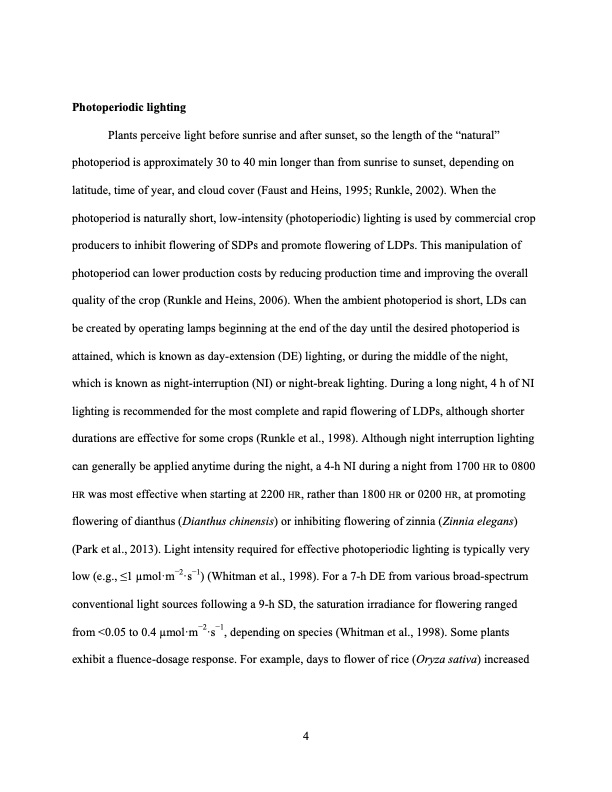
PDF Publication Title:
Text from PDF Page: 014
Photoperiodic lighting Plants perceive light before sunrise and after sunset, so the length of the “natural” photoperiod is approximately 30 to 40 min longer than from sunrise to sunset, depending on latitude, time of year, and cloud cover (Faust and Heins, 1995; Runkle, 2002). When the photoperiod is naturally short, low-intensity (photoperiodic) lighting is used by commercial crop producers to inhibit flowering of SDPs and promote flowering of LDPs. This manipulation of photoperiod can lower production costs by reducing production time and improving the overall quality of the crop (Runkle and Heins, 2006). When the ambient photoperiod is short, LDs can be created by operating lamps beginning at the end of the day until the desired photoperiod is attained, which is known as day-extension (DE) lighting, or during the middle of the night, which is known as night-interruption (NI) or night-break lighting. During a long night, 4 h of NI lighting is recommended for the most complete and rapid flowering of LDPs, although shorter durations are effective for some crops (Runkle et al., 1998). Although night interruption lighting can generally be applied anytime during the night, a 4-h NI during a night from 1700 HR to 0800 HR was most effective when starting at 2200 HR, rather than 1800 HR or 0200 HR, at promoting flowering of dianthus (Dianthus chinensis) or inhibiting flowering of zinnia (Zinnia elegans) (Park et al., 2013). Light intensity required for effective photoperiodic lighting is typically very low (e.g., ≤1 μmol·m−2·s−1) (Whitman et al., 1998). For a 7-h DE from various broad-spectrum conventional light sources following a 9-h SD, the saturation irradiance for flowering ranged from <0.05 to 0.4 μmol·m−2·s−1, depending on species (Whitman et al., 1998). Some plants exhibit a fluence-dosage response. For example, days to flower of rice (Oryza sativa) increased 4PDF Image | LED REGULATE FLOWERING OF PHOTOPERIODIC ORNAMENTAL CROPS

PDF Search Title:
LED REGULATE FLOWERING OF PHOTOPERIODIC ORNAMENTAL CROPSOriginal File Name Searched:
Meng_grad-msu_0128N_12984.pdfDIY PDF Search: Google It | Yahoo | Bing
Cruise Ship Reviews | Luxury Resort | Jet | Yacht | and Travel Tech More Info
Cruising Review Topics and Articles More Info
Software based on Filemaker for the travel industry More Info
The Burgenstock Resort: Reviews on CruisingReview website... More Info
Resort Reviews: World Class resorts... More Info
The Riffelalp Resort: Reviews on CruisingReview website... More Info
| CONTACT TEL: 608-238-6001 Email: greg@cruisingreview.com | RSS | AMP |